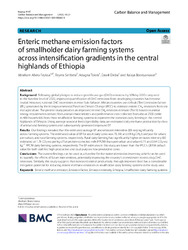| dc.contributor.author | Feyissa, Abraham Abera | |
| dc.contributor.author | Senbeta, Feyera | |
| dc.contributor.author | Tolera, Adugna | |
| dc.contributor.author | Diriba, Dawit | |
| dc.contributor.author | Boonyanuwat, Kalaya | |
| dc.date.accessioned | 2024-02-01T08:55:38Z | |
| dc.date.available | 2024-02-01T08:55:38Z | |
| dc.date.issued | 2023-11-29 | |
| dc.identifier.citation | Feyissa, A. A., Senbeta, F., Tolera, A., Diriba, D., & Boonyanuwat, K. (2023). Enteric methane emission factors of smallholder dairy farming systems across intensification gradients in the central highlands of Ethiopia. Carbon Balance and Management, 18(1), 23. | en_US |
| dc.identifier.issn | 17500680 | |
| dc.identifier.uri | 10.1186/s13021-023-00242-0 | |
| dc.identifier.uri | https://cbmjournal.biomedcentral.com/ | |
| dc.identifier.uri | https://hdl.handle.net/13049/728 | |
| dc.description | This article is published under OA, it is open to all, with no access fees. | en_US |
| dc.description.abstract | Background: Following global pledges to reduce greenhouse gas (GHG) emissions by 30% by 2030 compared to the baseline level of 2020, improved quantification of GHG emissions from developing countries has become crucial. However, national GHG inventories in most Sub-Saharan African countries use default (Tier I) emission factors (EFS) generated by the Intergovernmental Panel on Climate Change (IPCC) to estimate enteric CH4 emissions from animal agriculture. The present study provides an improved enteric CH4 emission estimate (Tier II) based on animal energy requirements derived from animal characteristics and performance data collected from about 2500 cattle in 480 households from three smallholder farming systems to represent the common dairy farming in the central highlands of Ethiopia. Using average seasonal feed digestibility data, we estimated daily methane production by class of animal and farming system and subsequently generated improved EF. Results: Our findings revealed that the estimated average EF and emission intensities (EI) vary significantly across farming systems. The estimated value of EF for adult dairy cows was 73, 69, and 34 kg CH4/cow/year for urban, peri-urban, and rural farming systems, respectively. Rural dairy farming had significantly higher emission intensity (EI) estimated at 1.78 CO2-eq per kg of fat protein-corrected milk (FPCM) than peri-urban and urban 0.71 and 0.64 CO2-eq kg−1 FPCM dairy farming systems, respectively. The EF estimates in this study are lower than the IPCC's (2019) default value for both stall-fed high-productive and dual-purpose low-productive cows. Conclusions: The current findings can be used as a baseline for the national emission inventory, which can be used to quantify the effects of future interventions, potentially improving the country's commitment to reducing GHG emissions. Similarly, this study suggests that increased animal productivity through improved feed has a considerable mitigation potential for reducing enteric methane emissions in smallholder dairy farming systems in the study area. | en_US |
| dc.language.iso | en | en_US |
| dc.publisher | BioMed Central Ltd | en_US |
| dc.relation.ispartofseries | Carbon Balance and Management;18(1), 23. | |
| dc.subject | Emission factor | en_US |
| dc.subject | Emission intensity | en_US |
| dc.subject | Enteric methane emission | en_US |
| dc.subject | Ethiopia | en_US |
| dc.subject | Smallholder dairy farming systems | en_US |
| dc.title | Enteric methane emission factors of smallholder dairy farming systems across intensification gradients in the central highlands of Ethiopia. | en_US |
| dc.type | Article | en_US |

